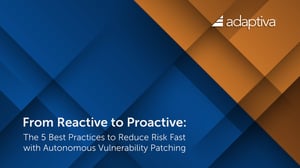
From Reactive to Proactive: 5 Best Practices for Autonomous Vulnerability Patching
Cyber threats are becoming faster and more pervasive every day, with endpoints being the primary attack vector. Organizations are struggling to keep up, often taking weeks or even months to patch critical vulnerabilities. This leaves systems exposed to potential breaches.
Did you know:
- Cyber adversaries have an average breakout time of just 62 minutes
- 90% of successful cyber attacks begin on an endpoint
- Fewer than 60% of devices are patched within 14 days
The traditional divide between IT operations and security teams leads to inefficient, manual patching processes that can't keep pace with the speed of threats. Siloed vulnerability management and patching leave gaps that adversaries exploit.
To accelerate patching and proactively address vulnerabilities, organizations need to bridge the gap between IT and security. An integrated, automated approach enables precise patching that aligns with your unique business requirements.
This eBook outlines 5 best practices to help you achieve autonomous vulnerability patching:
- Discover and assess vulnerabilities and patches for full visibility
- Model your remediation strategies to align with specific needs
- Automate patch deployments from approval to installation
- Monitor user experience and ensure flexible rollback controls
- Analyze patching results to track compliance in real-time
By shifting from reactive firefighting to proactive, coordinated patching, you can dramatically reduce your attack surface and prevent breaches before they happen. Download the eBook to learn how to implement these 5 critical best practices.1
Download
1*2024 CrowdStrike Global Threat Report; Cost of a Data Breach Report, Ponemon and IBM, 2022, State of Cyber Assets Report, JupiterOne, 2023


